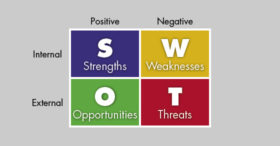With the year underway, your business probably has a strategic plan in place for the months ahead. Or maybe you’ve created a general outline but haven’t quite put the finishing touches on it yet. In either case, there’s a time-tested approach to refining your strategic plan that you should consider: a SWOT analysis. Let’s take a closer look at what each of the letters in that abbreviation stands for:
Strengths. A SWOT analysis starts by identifying your company’s core competencies and competitive advantages. These are how you can boost revenues and build value. Examples may include an easily identifiable brand, a loyal customer base or exceptional customer service.
Unearth the source of each strength. A loyal customer base, for instance, may be tied to a star employee or executive — say a CEO with a high regional profile and multitude of community contacts. In such a case, it’s important to consider what you’d do if that person suddenly left the business.
Weaknesses. Next the analysis looks at the opposite of strengths: potential risks to profitability and long-term viability. These might include high employee turnover, weak internal controls, unreliable quality or a location that’s no longer advantageous.
You can evaluate weaknesses relative to your competitors as well. Let’s say metrics indicate customer recognition of your brand is increasing, but you’re still up against a name-brand competitor. Is that a battle you can win? Every business has its Achilles’ heel — some have several. Identify yours so you can correct them.
Opportunities. From here, a SWOT analysis looks externally at what’s happening in your industry, local economy or regulatory environment. Opportunities are favorable external conditions that could allow you to build your bottom line if your company acts on them before competitors do.
For example, imagine a transportation service that notices a growing demand for food deliveries in its operational area. The company could allocate vehicles and hire drivers to deliver food, thereby gaining an entirely new revenue stream.
Threats. The last step in the analysis is spotting unfavorable conditions that might prevent your business from achieving its goals. Threats might come from a decline in the economy, adverse technological changes, increased competition or tougher regulation.
Going back to our previous example, that transportation service would have to consider whether its technological infrastructure could support the rigorous demands of the app-based food-delivery industry. It would also need to assess the risk of regulatory challenges of engaging independent contractors to serve as drivers.
Typically presented as a matrix (see accompanying image), a SWOT analysis provides a logical framework for better understanding how your business runs and for improving (or formulating) a strategic plan for the year ahead. Our firm can help you gather and assess the financial data associated with the analysis. Call us at 205-345-9898.
© 2019 Covenant CPA









